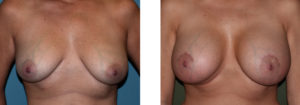One of the most important features of a good-looking breast is the position of the nipple on the mound. Ideally placed at the central meridian of the breast, the nipple-areolar complex (hereafter referred to as the nipple) and its position imparts a significant impression about the youthful or aged appearance of the breast. As the nipple drops lower from age or pregnancies, the breast shape becomes defined by the degree of ptosis or sagging. The well-known classification of breast ptosis is based on the vertical relationship of the nipple to the inframammary fold.
Minimal sag or a Grade 1 ptosis (nipple is lower but is still above or just at the level of the lower breast fold) can be improved by repositioning the nipple upward. This is known as a nipple lift or a crescent mastopexy. In this procedure, a crescent shaped section of skin is removed above the areola. The nipple is then pulled upward to a new position and sutured into place. This allows the top of the nipple to be repositioned upward by about 2 to 3 cms. and will move the nipple up about 1 to 1.5 cms. This maneuver usually makes the nipple look slightly larger or elongated.

As the nipple and breast sags further, more extensive breast lifts may be needed to achieve an ideal shape and nipple position. However, some women are understandably concerned about breast scars and may not be willing to accept an additional scar burden. In Grade II ptosis, a crescent lift with an implant may still be used as long as the patient is willing to accept less than an ideal result.
Dr. Barry Eppley
Indianapolis, Indiana


